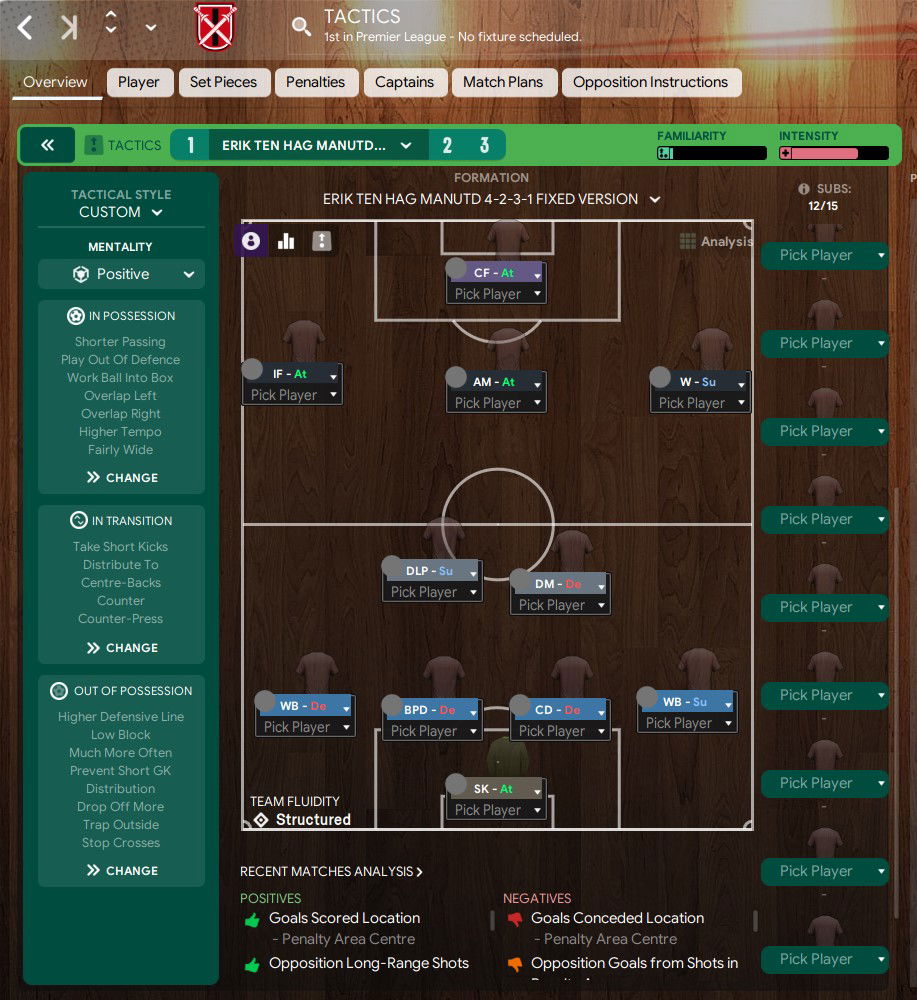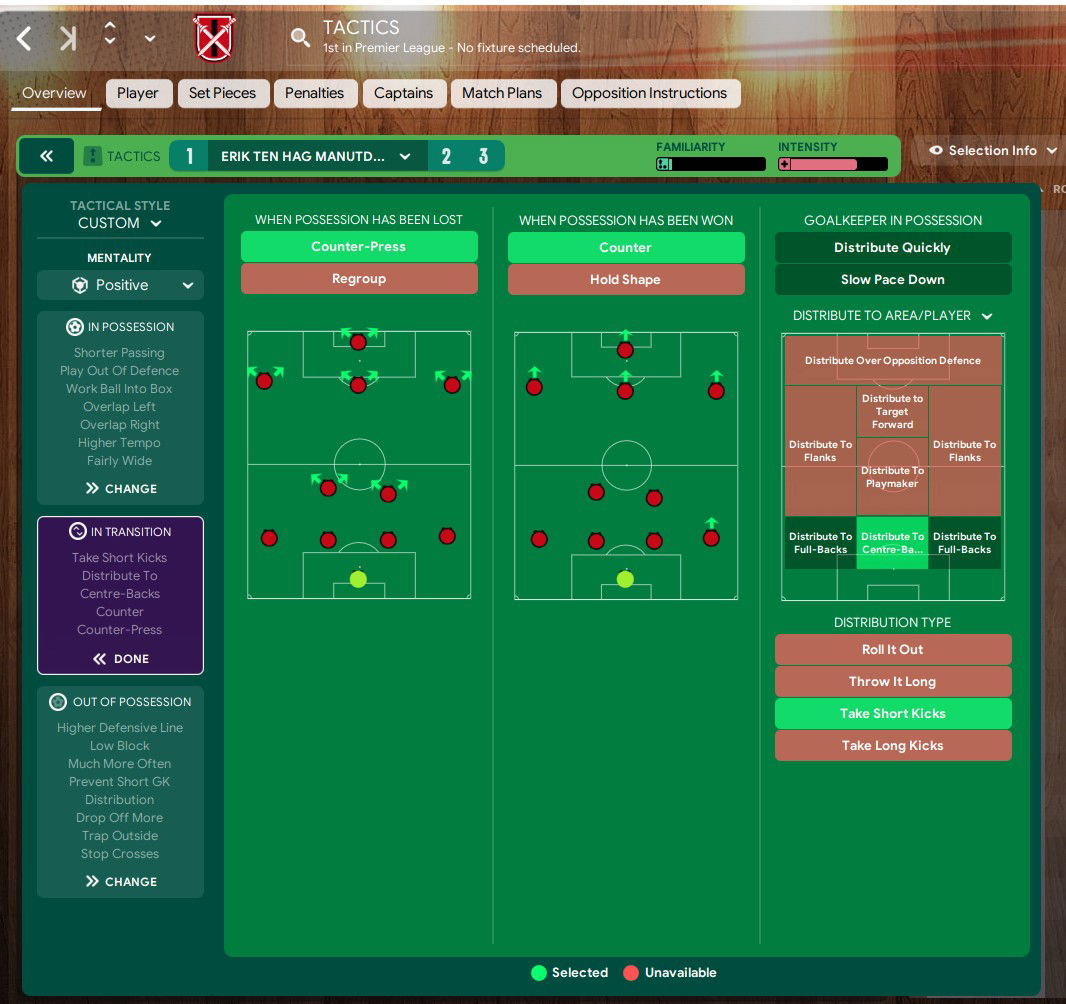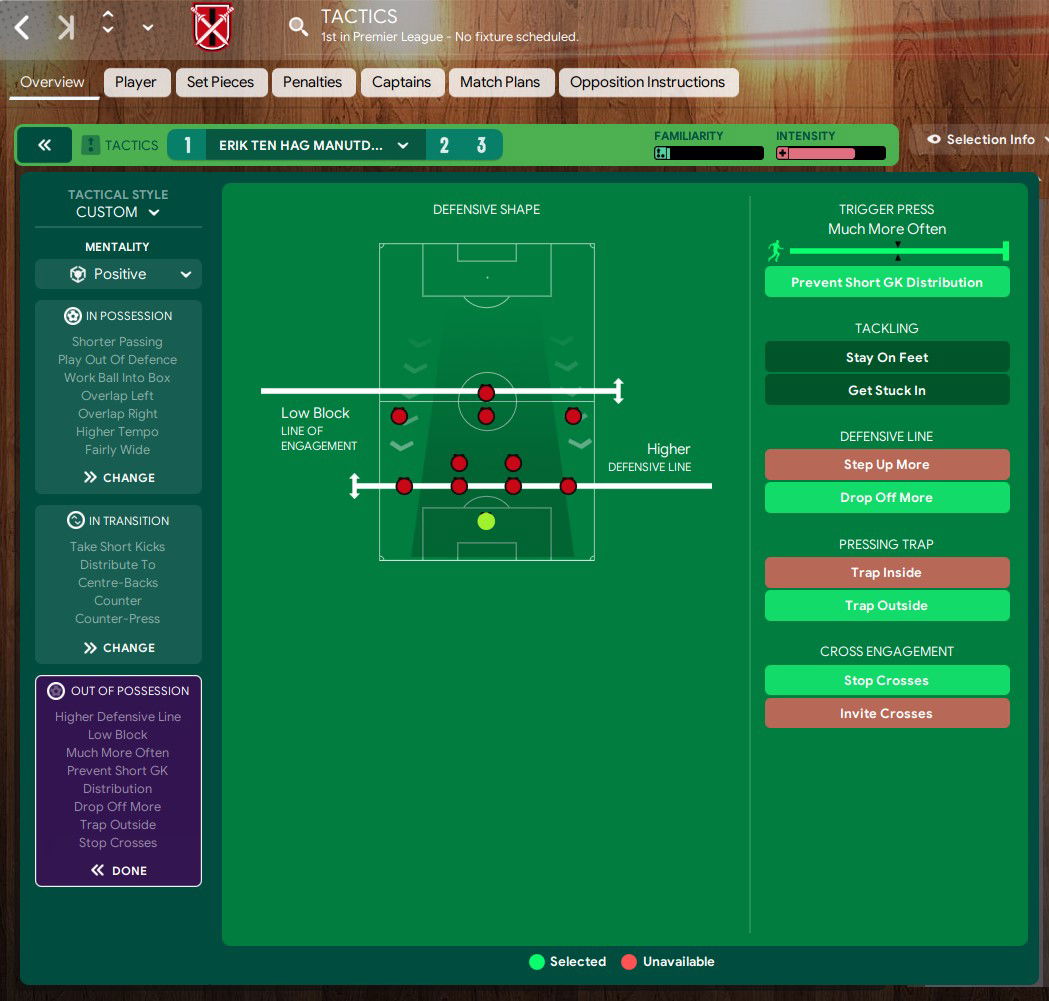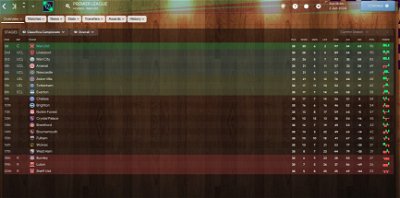| Tester | Team | ME | Win % | PPG | AGF | AGA | GD | PL | W | D | L | |
|---|---|---|---|---|---|---|---|---|---|---|---|---|
| Deleted User #1866315 |
 Manchester (Latacunga)
Manchester (Latacunga)
|
24.1.1 | 79% | 2.53 | 2.6 | 0.9 | 1.66 | 38 | 30 | 6 | 2 |
ERIK TEN HAG’S 4-2-3-1: TACTICAL ANALYSIS, MAINLY ISSUES AND WAY TO FIX THEM ON FOOTBALL MANAGER 2024
Erik ten Hag took over as the manager of Manchester United in the 2022-2023 season with high expectations surrounding his attacking style of play. However, the initial phase was marked by challenges, with defeats to Brighton and Brentford raising concerns. Despite subsequent victories against Arsenal and Liverpool, the team's success was attributed more to defensive tactics than the anticipated attacking prowess.
- Defensive Emphasis in Early Matches:
Ten Hag's tenure began with defensive struggles, evident in losses to Brighton and Brentford. These setbacks prompted a tactical shift, with a focus on defensive solidity. Wins against Arsenal and Liverpool were achieved with opponents dominating possession, showcasing a pragmatic approach to secure results.
Challenges in Implementing Attacking Style:
The initial difficulties suggest challenges in implementing Ten Hag's attacking philosophy. Factors such as player adaptation, tactical adjustments, and opposition analysis likely played a role. It's essential to consider the adjustment period required for both the manager and players to synchronize their styles.
Defensive Tactics Against Arsenal and Liverpool:
The victories against Arsenal and Liverpool highlighted a defensive approach, where Manchester United absorbed pressure and capitalized on counter-attacks. Possession stats favored the opponents, revealing a willingness to cede control while maintaining defensive shape.
Key Defensive Components:
Defensive Compactness: Ten Hag's team displayed a compact defensive shape, minimizing space for opponents in critical areas.
Counter-Attacking Efficiency: Transitioning from defense to attack quickly was pivotal, with players like Bruno Fernandes and Mason Mount providing a threat on the break.
Evolution and Adaptation:
Ten Hag's ability to adapt is crucial for future success. The initial emphasis on defense might be a strategic choice to establish a solid foundation before integrating more expansive attacking play. Continued adaptation and player development will likely be key factors in realizing Ten Hag's vision.
Erik ten Hag's early challenges at Manchester United underscore the complexities of implementing a new tactical philosophy. While defensive tactics have yielded results, the adaptation period and the eventual evolution toward a more attacking style will be closely monitored. As the season progresses, the blend of defensive resilience and attacking flair will define Ten Hag's impact on Manchester United's playing identity.
- Evolution After Cristiano Ronaldo's Departure and Tactical Flexibility
Following Cristiano Ronaldo's departure for Saudi Arabia post the Qatar World Cup 2022, Manchester United underwent a transformation in their playing style. The team's success became more apparent, characterized by dominance and a flexible tactical approach.
Formation and Eriksen's Role:
The team frequently operated in a fluid system that could be described as a 4-2-3-1 or a 4-1-2-3, contingent on Christian Eriksen's positioning. Eriksen played a pivotal role in transitions, forming a double pivot with Casemiro when dropping deep to receive the ball. As the play progressed, he seamlessly transitioned into one of the two attacking midfielders, creating a dynamic offensive structure.
Tactical Flexibility in Building Attacks:
The tactical fluidity extended to the team's approach in building attacks. Although there was no strict shape, they consistently deployed at least four players at the back to initiate the attack. Luke Shaw's adaptability was showcased when playing as a center-back, contributing to possession-building. Eriksen, one of the team's most flexible players, frequently dropped back alongside Casemiro to aid in building from the back.
Fullback Movement and Overlapping:
The fullbacks played a crucial role in the attacking strategy. When Shaw played as a left fullback, he often stayed back, allowing Eriksen to position himself between the lines. Meanwhile, the right fullback advanced forward. The positional interchanges were not limited to the front line; occasionally, one of the fullbacks moved inside next to Casemiro for added support.
Defensive Adaptations:
Defensively, the team showcased adaptability. For instance, when Shaw played as a left fullback, he sometimes overlapped with the left-winger Rashford, creating diverse attacking options. Casemiro's occasional inclusion in the backline formed a back three against the opposition's two strikers, providing a numerical advantage, with Eriksen serving as the pivot.
Attacking in the Final Third:
The team faces challenges when opponents have a numerical advantage at the back, affecting the effectiveness of creating a numerical advantage upfront.
A key skill involves the center-back stepping in to prevent the opposition from exploiting spaces, especially against wide midfielders.
Defensive Adaptations:
The absence of a quality left full-back has led to a counter-pressing defensive style.
Vulnerabilities arise when opponents exploit the flanks, exposing the double pivot's difficulty in covering large spaces during transitions.
Tactical Flexibility:
The team showcases flexibility, with players like Casemiro joining the attack and Eriksen dropping back as a pivot to support transitions.
The final third tactics resemble those used at Ajax, emphasizing attackers' talents but highlighting the need for improvement.
Pressing:
Without Ronaldo, the team can press high in a 4-3-3 shape, resembling classic Liverpool pressing.
Midfielders mark opposition players instead of forming a defensive line, making them susceptible to being beaten if the press fails.
Final Third Defending:
Focus on marking opposition players, with duels crucial in defending.
Defenders and defensive midfielders, notably Casemiro and Eriksen, contribute to solid defensive efforts, but there's vulnerability when facing strong teams.
Conclusion:
Manchester United's tactical approach under Erik ten Hag exhibits both strengths and areas for improvement, emphasizing adaptability, defensive resilience, and reliance on individual talents. Adjustments in the final third and during defensive transitions are highlighted as key areas requiring attention.
- Season 2023-24: a return to a defensive style? Defensive Challenges and Adaptations: Lack of Left-Back and Counter-Pressing Style
In the current season, Manchester United has faced defensive challenges, particularly on the left flank due to long-term injuries to Shaw and Malacia. The absence of a natural left-back capable of providing width has prompted tactical adjustments, and Erik ten Hag has implemented a counter-press defensive style.
Left-Back Dilemma:
The injuries to Shaw and Malacia have left a void at left-back, with Diogo Dalot, a right-back adapted to the left, unable to replicate the same attacking contributions. This deficiency in width on the left side has been evident in the team's offensive play.
Counter-Press Defensive Style:
In response to the defensive challenges and the absence of a traditional left-back, Ten Hag has opted for a counter-pressing defensive approach and a direct passing style. This strategy involves four players pressing high up the pitch, attempting to disrupt the opponent's build-up play. Meanwhile, the remaining six players maintain a defensive shape, creating a structured defensive block.
Vulnerabilities in Defensive Transition:
Despite the counter-pressing strategy, vulnerabilities have emerged, particularly highlighted in the game against Manchester City. When opponents successfully navigate the press and exploit the flanks, the large space between the pressing line and the defensive block becomes a concern. The double pivot of Amrabat and Casemiro struggles to cover this expansive area, and the backline can face numerical disadvantages against the opponent's attacking players.
Adaptation and Strategic Shifts:
The tactical adjustments suggest a temporary shift in emphasis, with a greater focus on defensive solidity to address the challenges posed by the absence of a reliable left-back. The team has, at times, sacrificed width in favor of a more cautious approach.
Conclusion:
The defensive challenges arising from the lack of a proficient left-back have led to tactical adaptations by Erik ten Hag. The counter-pressing defensive style has been employed to disrupt opponents' play, but vulnerabilities have been exposed, especially when opponent teams exploit the wide areas. It appears that, for the time being, the emphasis on attacking flair has been tempered to prioritize defensive stability, highlighting Ten Hag's ability to adapt to the circumstances and make pragmatic decisions for the team's benefit.
HOW TO EMULATE THIS TACTIC AND FIX ITS ISSUES ON FOOTBALL MANAGER 2024
I decided to emulate Erik Ten Hag’s tactic on FM 24 with the aim to create a more attacking style and not the defensive play we are seeing in this season.
I want my team to dominate the game, possession and expected goals and create many chances to score. Rashford, Hojlund, Bruno Fernandes, Mason Mount and Jadon Sancho (even if Ten Hag does not want to let him in) are surely not top players like Erling Haaland, Kevin De Bruyne or Mbappe, but they can score more than they do. I mean, having seen how they lost 3-4 the game against Copenhagen and they struggled against Luton winning only 1-0 makes me think a lot about what the Dutch manager should do as soon as possible to fix all the issues.
First of all, the lack of a good left wing-back, we can train one of our players to replace Luke Shaw or we can scout for one.
As for the vulnerabilities in Defensive Transition, we can start by adjusting pressing intensity, if opponents are easily bypassing our press, we can consider increasing the pressing urgency or using a higher defensive line.
Another important thing is to modify midfield setup, adjust the roles and duties of our central midfielders to ensure better coverage of spaces in wide areas.
Lastly, we should provide specific instructions to our full-backs during defensive transitions.
So, let’s see how I emulated this 4-2-3-1
First of all, let’s examine the team instructions.
- Team Instructions
- In possession
Mentality: A balanced mentality is a good starting point. It provides a middle ground, allowing the team to both attack and defend effectively. It can be adjusted based on in-game situations.
Attacking Width: A fairly wide or balanced width is often suitable for a 4-2-3-1, allowing our team to utilize the width of the pitch while maintaining a compact shape.
Overlap or Underlap:
Wan Bissaka is an attacking full-back so I choose "overlap" to encourage him to join the attack. On the left, Dalot is a bit more defensive player so I will ask him to overlap but at same time will focus our play more on the right.
Pass into Space:
Considering players like Sancho, Rashford, and potentially Eriksen, using "pass into space" could exploit their pace and movement effectively.
Play Out of Defense:
Given Onana's proficiency with playing out from the back, "play out of defense" is recommended. This helps maintain possession from the goalkeeper to build up play.
Passing Directness:
A "shorter" passing directness suits the 4-2-3-1 formation, encouraging our team to play short, quick passes, maintaining possession and controlling the game.
Tempo:
A "slightly higher" tempo can be effective, especially in quick transitions from defense to attack. It can be adjusted based on the situation and the flow of the game.
Crosses:
Consider a "mixed" crossing instruction. This provides flexibility, allowing players to choose the appropriate type of cross based on the situation.
Work Ball into Box:
Our players in the attacking third are technically skilled and using "work ball into box" can encourage patience and precision in the final third.
- In transition instructions
Considering Ten Hag's tactics and the desire for a dynamic style of play, "Counter Press" could be a suitable choice. This encourages our players to press high immediately after losing possession to regain the ball quickly.
When Winning the Ball Back, I choose “Counter”: given the attacking talents in our squad, opting for "Counter" when winning the ball back can exploit the spaces left by the opponent during their attacking phase.
(Alternatively, "Hold Shape" can be effective, especially against strong opponents. It allows our team to regain composure, maintain possession, and control the tempo before launching a structured attack.)
Regarding Onana's Distribution:
Passing the Ball:
Onana should ideally pass the ball to the center-backs. this allows our team to build up play from the back.
Taking Short Kicks:
With Onana's proficiency in playing out from the back, I decided to instruct him to take short kicks. This aligns with the philosophy of building from defense and involving the goalkeeper in the possession phase.
- Out of possession instructions
Pressing Line:
Considering Ten Hag's preference for an aggressive style, setting the pressing line to "Very High" could be appropriate. This aligns with the concept of pressing high up the pitch to disrupt the opponent's build-up.
Defensive Line:
The defensive line can be set to "Higher" or even "Much Higher" to compress the playing space and limit the opponent's options. This is in line with Ten Hag's inclination towards a high defensive line to put pressure on the opposition.
Pressing Trigger:
"Often" or "Much More Often" for the pressing trigger can be effective in quickly engaging the opposition when they enter our defensive third. This encourages an immediate response to regain possession.
Prevent GK Short Distribution:
To disrupt the opponent's build-up from the back, instructing our players to "Prevent Goalkeeper Short Distribution" can be effective. This encourages our team to press the goalkeeper and limit short passing options.
2. Players roles and personal instructions
GK: Andre Onana: sweeper-keeper (attack), pass it shorter.
This role allows Onana to sweep behind the defensive line and initiate attacks from the back. The instruction “pass it shorter” encourages short passes and build-up play from the back.
RB: Aaron Wan-Bissaka: wing- back (support), stay wider, get further forward, cross on far post.
Choose the Wing Back (Support) role to provide Wan-Bissaka with more attacking freedom. This role encourages him to push forward, overlap the winger, and contribute to the offensive phase.
Stay Wider: Instruct Wan-Bissaka to stay wider, stretching the opposition defense and providing width on the right flank.
Get Further Forward: This instruction encourages him to join the attack more actively, making overlapping runs and getting involved in offensive plays.
By adjusting the role and player instructions, I can focus the play on the right side, allowing Wan-Bissaka to contribute more to the attack.
RCB: Raphael Varane: Central Defender (Defend): take less risks, close down less, pass it shorter, stay wider.
This role suits Varane's profile as a strong and composed defender. The Central Defender (Defend) role ensures that he prioritizes defensive duties, helping to maintain a solid backline.
Stay wider: he can cover the right flank when our team is in possession and Van Bissaka gets forward leaving spaces behind him.
Take less risks: this instructs Varane to stay back during attacking phases, maintaining defensive discipline and preventing potential counter-attacks.
Pass it shorter: this instructs Varane to make short passes and helps to build the play from the back.
Close down less instructs Varane to avoid pressing the opponent leaving space behind him.
LCB: Lisandro Martinez: Ball Playing Defender (Defend): close down more, dribble more, pass it shorter.
This role is suitable for Martínez, as it encourages him to play out from the back and contribute to the team's possession play. It aligns with Ten Hag's emphasis on playing out from defense.
Dribble More to allow him to carry the ball forward when space opens up.
Close down more: different to Varane, I want Martinez to press high and break the opponent’s play.
Pass it shorter: as for Varane, this instructs Martinez to make short passes and helps to build the play from the back.
LB: Diogo Dalot: Full-Back (support): stay wider, cross on far post.
This role suits Dalot's defensive tendencies while allowing him to contribute to the attack when the opportunity arises. It provides a good balance between defense and support.
Stay wider: encourage Dalot to stay wider, providing width to the left flank and stretching the opposition's defensive shape.
RM: Casemiro: Defensive Midfielder (Defend): tackle harder, pass it shorter
This role allows Casemiro to sit in front of the defense, acting as a shield and providing strong defensive cover. If we want him to focus more on interceptions and positioning we can choose the defensive midfielder role, alternatively, if we want him to focus more on aggressive ball-winning we can choose the ball- winning midfielder role. Player Instructions:
Tackle harder: Given Casemiro's prowess in tackling, I added the "tackle harder" instruction because I want him to be more aggressive in winning the ball.
Pass it Shorter: To align with a possession-oriented style, I instruct Casemiro to pass the ball shorter, maintaining ball control and initiating attacks from deep.
Deploying Casemiro as a dedicated defensive midfielder in a 4-2-3-1 provides a solid foundation for the team, allowing the attacking players to focus on their creative responsibilities while he ensures defensive stability.
LM: Amrabat: Deep-Lying Midfielder (Support): pass it shorter
This role suits a player who operates just in front of the defense, helping with ball distribution and controlling the tempo of the game.
The Deep-Lying Playmaker role allows Amrabat to contribute defensively, distribute the ball, and act as a link between the defense and the attacking players.
RAM: Jadon Sancho: Winger (Attack) : no instructions
This role encourages Sancho to stay wide and deliver crosses into the box. It suits a more traditional style of wing play.
LAM: Marcus Rashford: Inside Forward (Attack): stay wider
This role encourages Rashford to cut inside from the left flank, aiming to be a goal-scoring threat and link up with central attackers.
Stay wider: this instructs Rashford to stay wider and stretch the opposition defense creating spaces in the centre
The Inside Forward role complements ten Hag's attacking philosophy by providing a goal-scoring threat from the left side.
CAM: Bruno Fernandes: Advanced Playmaker (Attack): roam from position, get further forward, pass it shorter.
This role suits Fernandes' playmaking abilities, allowing him to link up with attackers, find spaces in the final third, and create goal-scoring opportunities.
Roam from Position: Enable Fernandes to roam from his position, giving him the freedom to find pockets of space and influence different areas of the pitch.
Get Further Forward: Encourage Fernandes to get further forward, ensuring he positions himself in goal-scoring areas during attacking phases.
Pass it Shorter: Align with a possession-oriented style by instructing Fernandes to pass the ball shorter, maintaining control in the attacking third.
The Advanced Playmaker role allows Fernandes to be a central creative force, linking up with the attack and providing key passes. Adjustments can be made based on your specific tactical preferences and the strengths of Fernandes.
CF: Rasmus Hojlund : Complete Forward (Attack): no instructions
This role is suitable for a player like Hojlund who possesses a well-rounded skill set, allowing him to lead the line, score goals, and link up play.
That’s all for my tactic, I hope it works for you too.
Test Results
 Manchester (Latacunga)
Manchester (Latacunga)
You'll need to Login to comment




